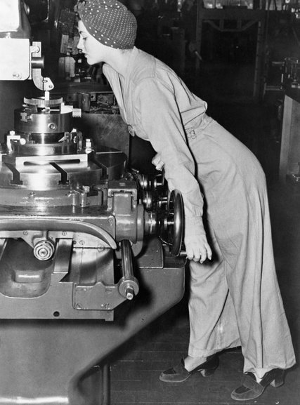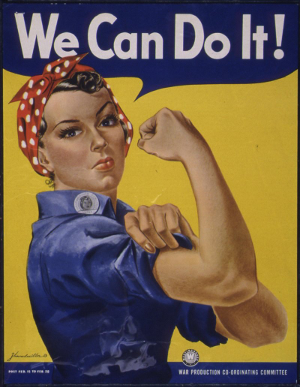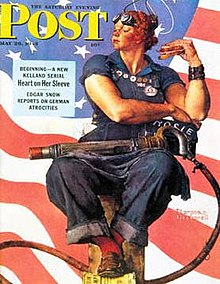|
Rosie the Riveter Inspiration Dead at 96 January 23, 2018
The inspiration for the iconic Rosie the Riveter, symbol of wartime women's "We Can Do It!" attitude, has died. Naomi Parker Fraley was 96 when she died in Longview, Wash. A longtime California resident, Fraley was not long identified as Rosie the Riveter; instead, another woman lay claim to that identity for several decades. Naomi was born to Joseph and Esther Parker in Tulsa, Olka, on August 26, 1921. Naomi's parents eventually had eight children, of which Naomi was third-oldest. Joseph Parker was a mining engineer, and the family moved around a fair bit, living in Missouri, New York, Texas, and Utah before finally settling in California, in Alameda. The Parker family was living in Alameda, which is near San Francisco, on Dec. 7, 1941, when Japanese forces attacked Pearl Harbor. Naomi was 20 at the time; she and her 18-year-old sister Ada found work at the Naval Air Station in the town in which they lived. They worked in the machine shop; among their tasks were patching airplane wings, drilling, and–of course–riveting. The next year, a photographer for the Acme photo agency took a picture of young Naomi, wearing a polka-dot bandanna, at an industrial lathe. The picture found wide release but seldom appeared with a photo caption, identifying the woman in the photo or the factory in which the photo was taken. The photo was, historians think, the inspiration for the far more famous 1943 poster designed by Pittsburgh artist J. Howard Miller, in which the famous female worker flexes her arm and declares "We Can Do It!" The image of Rosie the Riveter was a powerful reminder that women could do many jobs just as competently as men could–and often better–;Rosie also gave women confidence to help the war effort by taking jobs that were suddenly vacant in the hundreds of thousands. The poster was designed to be seen only in plants owned by Westinghouse Electric Corporation; the image took on a life of its own, however, and was published far and wide–in newspapers and magazines and in reproductions on walls across the country. Naomi Parker was one of more than 6 million women who left the factories when American servicemen came home after the end of World War II. She found work as a waitress at the Doll House, a Palm Springs restaurant in which many Hollywood stars ate. She was married three times and had a son, four stepsons, two stepdaughters, and then three grandchildren, three great-grandchildren, and many step-grandchildren and step-great-grandchildren. In all that time, however, another woman was being credited as the inspiration for Rosie the Riveter. That was Geraldine Doyle, a Michigan woman who worked as a metal presser. In 1984, Doyle saw the 1942 photo of Naomi Parker and thought it looked like her. In 1994, she saw the Miller poster, again of Naomi Parker; again, Doyle thought the image looked like her. She did not know of Naomi Parker and did not know that she was the woman in the 1942 photo and in the subsequent photo-inspired poster. The two women looked very much alike. Doyle continued to say that she was the inspiration for the Rosie the Riveter poster until she died in 2015; most media depictions of Rosie listed Doyle as her inspiration. Also complicating matters were two other cultural depictions of Rosie the Riveter: a well-known wartime song of the same name and a Normal Rockwell Saturday Evening Post cover that showed a strong-looking female worker sporting a lunchbox with "Rosie" on it. This Rosie had no bandanna and otherwise looked quite different from the woman in the Miller poster. The Rockwell cover was soon forgotten, as was the song. But the Miller poster found new life in feminist movements of the 1970s and 1980s, and it is there that the story intersects with the life of Doyle. In 2011, Naomi Parker, by this time Naomi Parker Fraley, attended a California reunion of female war workers at the Rosie the Riveter/World War II Home Front National Historic Park. Displayed prominently at the reunion, which took place in Richmond, was the 1942 photograph, with a caption reading "Geraldine Doyle." Fraley wrote to the National Park Service, administrator of the historic park, to try to set the record straight; she was unsuccessful. Whether she had tried to do so before seeing that poster in 2011 isn't known. It was not until 2016, a year before her death, that Naomi Parker Fraley's role as the inspiration for the famous Rosie the Riveter was cemented, thanks in large part to Seton Hall University professor James Kimble, who published a journal article in that year detailing his research and conclusion. Among Kimble's findings was another photo from 1942, showing the same woman, and having a caption that read "Pretty Naomi Parker looks like she might catch her nose in the turret lathe she is operating.”
|
Social Studies for Kids |
Social Studies for Kids
copyright 2002–2019
David White






